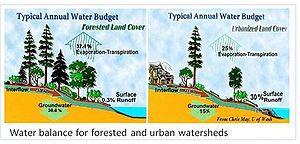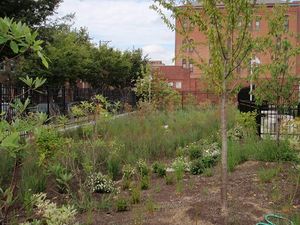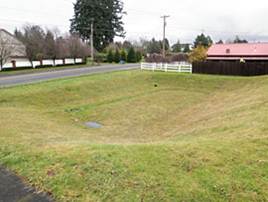
Minnesota Stormwater Manual test page 5
Contents
Proposed portal for Green Infrastructure
- Overview of green infrastructure
- Stormwater management and green infrastructure
- Green infrastructure and climate adaptation
- Enhancing biodiversity with stormwater management
- Benefit-costs of green infrastructure stormwater management
- Case studies
- Green Infrastructure resources
- Links
Overview of green infrastructure
Green infrastructure is an approach to managing urban wet weather impacts that mimics, restores, or maintains natural hydrology. Green infrastructure includes a wide array of practices, including infiltrating, evapotranspiring, or harvesting and using stormwater. On a regional scale, green infrastructure is the preservation or restoration of natural landscape features, such as forests, floodplains and wetlands. On the local scale, green infrastructure consists of site and neighborhood-specific practices, such as bioretention, trees, green roofs, permeable pavements and cisterns. Regional and local practices are coupled with policies such as infill and redevelopment that reduce overall imperviousness in a watershed.
This page provides a summary of green infrastructure, including a discussion of urban hydrology and water quality, an overview of green infrastructure practices, and benefits of green infrastructure. Links to other pages in the manual are provided at the end of this article.
Urban hydrology and water quality

The section called Overview of basic stormwater concepts provides an in-depth discussion of urban stormwater, including it's effects on hydrology and water quality. In a forested watershed, the majority of precipitation infiltrates the soil and subsequently percolates deeper into groundwater or is evapotranspired back to the atmosphere. As urban development increases, the paving of pervious surfaces (that is, surfaces able to soak water into the ground) with impervious roads, shopping centers, driveways and rooftops means less water soaks into the ground and more water runs off. The result is increased runoff volumes, increased peak runoff discharges, greater runoff velocities, increased flooding, increased scouring of streams and streambanks, and less subsurface flow to streams (baseflow). These processes dramatically change the morphology and biology of urban stream systems, to a point where they often can no longer support a viable biologic assemblage.
Water quality is also impacted. The water that washes over these new urban surfaces picks up materials laying upon those surfaces. The sediment from construction erosion, the oil, grease and metals from many automobiles, the fertilizer and pesticides from lawns, and many more new pollutants can adversely impact the receiving waters. There are several nonpoint sources of pollution, each with a distinct set of pollutants of concern. See the section on Pollutant fate and transport in stormwater infiltration systems to learn more about the transport and fate of pollutants in urban stormwater runoff.
Green infrastructure practices
A fundamental component of green infrastructure is retaining precipitation near the location where it falls. This requires capturing and retaining the water and allowing it infiltrate or be utilized by plants. The basic stormwater practices that achive this include the following.
- Bioinfiltration, also called rain gardens. Bioinfiltration basins, often called rain gardens, use soil (typically engineered media or mixed soil) and native vegetation to capture runoff and remove pollutants. Both the media and underlying soil typically have high infiltration rates that allow captured water to infiltrate within a required drawdown time, usually 48 hours. For more information, link here.
- Infiltration practices. These practices include infiltration basins, infiltration trenches, dry wells, and underground infiltration systems. Infiltration basins, trenches, and dry wells are aboveground structures or impoundments that capture, temporarily store, and infiltrate stormwater runoff. Drawdown of this stored runoff occurs through infiltration into the surrounding naturally permeable soil. The required drawdown time is 48 hours or less. Underground infiltration systems often consist of pre-manufactured pipes, vaults, and modular structures. Underground systems are often used as alternatives to infiltration basins and trenches for space-limited sites and stormwater retrofit applications. Underground infiltration systems are occasionally the only stormwater BMP options on fully developed sites as they can be located under other land uses such as parking lots or play areas. Like aboveground practices, underground systems must drawdown captured water within 48 hours.
Resources
Green infrastructure: Back to basics
Green infrastructure - wikipedia
What is Green Infrastructure? - EPA
Stormwater management: Low-impact development and green infrastructure
Professional Practice - Green Infrastructure - American Society of Landscape Architects
Green Infrastructure - City of Portland Oregon
Green Infrastructure and Climate Change: Collaborating to Improve Community Resiliency
Green Infrastructure, The Conservation Fund
Anne G. thoughts for Green Infrastructure Web Page in Stormwater Manual
Include:
'Definition of GI:' this is what’s in the manual now:
green infrastructure -means a wide array of practices at multiple scales that manage wet weather and that maintains or restores natural hydrology by infiltrating, evapotranspiring, or harvesting and using stormwater. On a regional scale, green infrastructure is the preservation or restoration of natural landscape features, such as forests, floodplains and wetlands, coupled with policies such as infill and redevelopment that reduce overall imperviousness in a watershed. On the local scale, green infrastructure consists of site and and neighborhood-specific practices, such as bioretention, trees, green roofs, permeable pavements and cisterns
Notice all the green call-out boxes for green infrastructure.
'GI BMP’s: '
- Permeable pavement (link to page)
- Green roofs (link to page)
- Harvest and Use (link to page)
- Trees (link to page)
- Bioretention (link to page)
- Infiltration
'GI and Climate Change/Adaptation/Resiliency'
- EPA: State Water Agency Practices for Climate Change Adaptation: https://www.epa.gov/sites/production/files/2015-10/documents/mn_stormwater_manual_final.pdf
- EPA: Flood Loss Avoidance Benefits of Green Infrastructure for Stormwater Management: https://www.epa.gov/sites/production/files/2016-05/documents/flood-avoidance-green-infrastructure-12-14-2015.pdf
- EPA Green Infrastructure for Climate Resiliency Infographic: https://www.epa.gov/file/green-infrastructure-climate-resiliency-infographic
- Link to MPCA’s climate adaption strategy: https://www.pca.state.mn.us/sites/default/files/p-gen4-10.pdf
- Link to MN Interagency Climate Adaption Team report: https://www.pca.state.mn.us/sites/default/files/p-gen4-07.pdf:
The MPCA’s Stormwater Program has been addressing the issues related to climate change adaptation since 2005 with the first issuance of the Minnesota Stormwater Manual. It advanced the concept of treating water on site, using low impact design, and volume control best management practices (BMPs). Since then, stormwater permits have advanced these BMPs, and MPCA has worked to set goals and quantify credits for using these BMPs through the Minimal Impact Design Standards (MIDS) Project. Consistent with MIDS are BMPs that can increase infiltration and reduce runoff (including green infrastructure like rain gardens, urban forestry/trees, pervious pavement, swales, etc.) Local units of government have traditionally worked to get water off the landscape as quickly as possible. In the last couple of decades, the MPCA has started addressing pollutant and rate control. We are now beginning to address volume control. Volume control, and working to mimic natural hydrology, helps to result in less dramatic runoff events, which reduces stream erosion and scouring. Impervious surfaces are increasing faster than population growth. This increase in impervious surface coupled with larger storm events will have a significant impact on receiving waters. Stormwater capture and reuse is an opportunity to reduce runoff and reap benefits from heavier rainfalls while reducing demands on the potable water supply.
NOAA Atlas 14 updates are being utilized to more accurately reflect precipitation intensities and durations. NOAA Atlas 14 incorporates 50 additional years of data into the estimate of precipitation 27 intensity and durations, and could account for changes that may be related to climate change. These estimates, used as an engineering standard, are vital to ensure proper design of culverts, storm sewers, and water quality devices.
In August 2013, the reissued Municipal Separate Storm Sewer System (MS4) General Permit became effective, which regulates stormwater discharge from counties, cities, townships and other publicly owned entities in urbanized areas. The goal of the MS4 program is to prevent or reduce the discharge of pollutants to stormwater, and ultimately, surface waters. This permit’s provisions will help to address problems of erosion and water pollution associated with heavy precipitation events.
Portfolio of green infrastructure in Minnesota (by region)
Green Infrastructure in schools
'GI and health benefits:'
'GI and sustainable communities:' EPA: Enhancing Communities with Green Infrastructure: https://www.epa.gov/smartgrowth/enhancing-sustainable-communities-green-infrastructure
'Green Streets and Living Streets. City of North St. Paul: http://www.ci.north-saint-paul.mn.us/vertical/sites/%7B5F63881B-2F96-4032-818C-7F4AD3529485%7D/uploads/%7BAF05CD7B-64EC-4FA8-A5BF-55F91637C22A%7D.PDF and City of Maplewood: http://maplewoodmn.gov/1014/Living-Streets
'For municipalities: '
Integrating GI : EPA: GI Opportunities that Arise During Municipal Operations: https://www.epa.gov/sites/production/files/2015-09/documents/green_infrastructure_roadshow.pdf Meet permit requirements with GI:
'GI Costs/Benefits'
GI and brownfield development:
'Link to other reports:'
EQB

